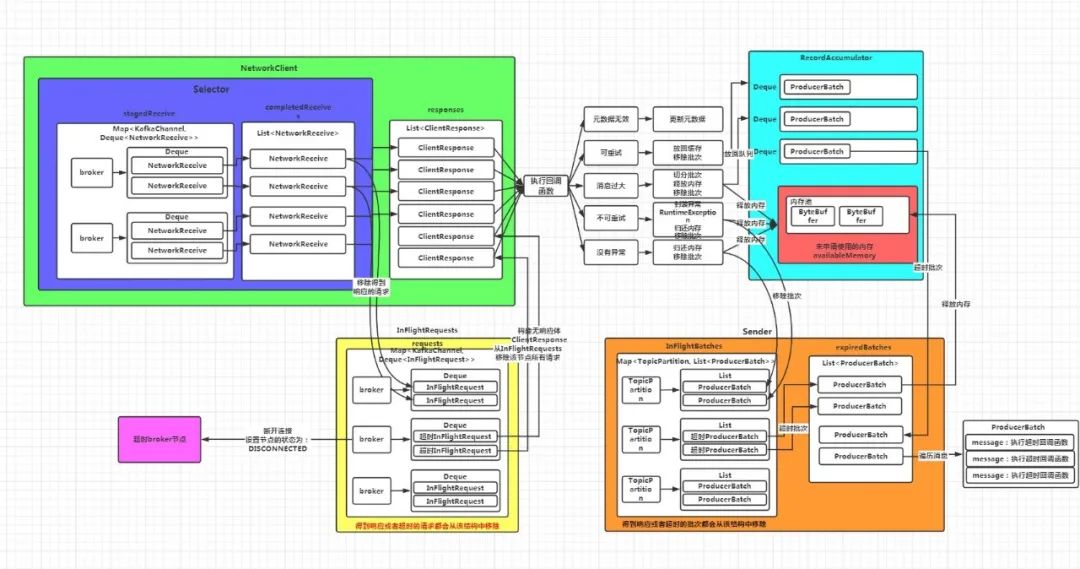一、场景分析
前面提到,消息封装成批次对象ProducerBatch后,会放到RecordAccumulator对应的Deque队列,等待Sender线程去发送。但是封装好的批次会有一个时间限制,如果超过这个时间限制还未发送成功,那么就会将该批次标记为超时批次,从而执行相应的处理。那么客户端如何处理这种超时的批次呢?为什么超时批次会导致数据重复?这篇进行详细的分析。 二、图示说明首先更正一下《深入理解Kafka客户端之服务端响应及超时请求的处理》中的流程图,图中少画了一个数据结构:InFlightBatches,这个结构保存的是正在发送的批次。当Sender线程将缓存中的批次拿出来封装成请求的同时,会将这个批次放到InFlightBatches结构中,即标记这些批次正在发送,当发送成功,会将这个批次从InFlightBatches中移除,同样,如果批次超时,也会将该批次移除。
超时批次的处理主要在右下角Sender线程这块:
三、过程源码分析
还是从Sender的runOnce方法看起,主要看下面的代码:
long pollTimeout = sendProducerData(currentTimeMs);private long sendProducerData(long now) {
... //TODO 步骤六:对超时批次对处理(由于没有建立网络连接,第一次这里的代码也不执行)这里的超时指生成的批次超过120s未发送或者发送了未返回响应 //获取inflightBatches集合中已经超时的批次, // inflightBatches记录的是从缓存中取出来的批次,上面进行合并时,将批次从Deque中取出来 List expiredInflightBatches = getExpiredInflightBatches(now); //获取缓存中已经过期的批次,这里指还未发送就已经超时的批次 List expiredBatches = this.accumulator.expiredBatches(now); //获取总的过期的批次 expiredBatches.addAll(expiredInflightBatches); if (!expiredBatches.isEmpty()) log.trace("Expired {} batches in accumulator", expiredBatches.size()); //遍历处理过期的批次 for (ProducerBatch expiredBatch : expiredBatches) {
String errorMessage = "Expiring " + expiredBatch.recordCount + " record(s) for " + expiredBatch.topicPartition + ":" + (now - expiredBatch.createdMs) + " ms has passed since batch creation"; //TODO 处理超时的批次 failBatch(expiredBatch, -1, NO_TIMESTAMP, new TimeoutException(errorMessage), false); if (transactionManager != null && expiredBatch.inRetry()) {
// This ensures that no new batches are drained until the current in flight batches are fully resolved. transactionManager.markSequenceUnresolved(expiredBatch.topicPartition); } } ...}List<ProducerBatch> expiredInflightBatches = getExpiredInflightBatches(now);private ListgetExpiredInflightBatches(long now) {
List expiredBatches = new ArrayList<>(); for (Iterator>> batchIt = inFlightBatches.entrySet().iterator(); batchIt.hasNext();) {
Map.Entry> entry = batchIt.next(); //获取每个分区对应的List集合 List partitionInFlightBatches = entry.getValue(); //说明指定的分